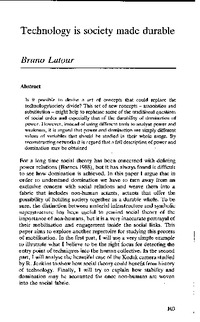Technology is society made durable Publikationsdatum:
Zu finden in:
|
 |
 Diese Seite wurde seit 3 Jahren inhaltlich nicht mehr aktualisiert.
Unter Umständen ist sie nicht mehr aktuell.
Diese Seite wurde seit 3 Jahren inhaltlich nicht mehr aktualisiert.
Unter Umständen ist sie nicht mehr aktuell.
 Zusammenfassungen
Zusammenfassungen
 Is it possible to devise a set of concepts that could replace the
technology/society divide? This set of new concepts - association and
substitution - might help to rephrase some of the traditional questions
of social order and especially that of the durability of domination of
power. However, instead of using different tools to analyse power and
weakness, it is argued that power and domination are simply different
values of variables that should be studied in their whole range. By
reconstructing networks it is argued that a full description of power and
domination may be obtained.
Is it possible to devise a set of concepts that could replace the
technology/society divide? This set of new concepts - association and
substitution - might help to rephrase some of the traditional questions
of social order and especially that of the durability of domination of
power. However, instead of using different tools to analyse power and
weakness, it is argued that power and domination are simply different
values of variables that should be studied in their whole range. By
reconstructing networks it is argued that a full description of power and
domination may be obtained. For a long time social theory has been eoneerned with defining power relations (Barnes 1988), but it has always found it difficuIt to see how domination is aehieved. In this paper I argue that in order to understand domination we have to turn away from an excIusive concern with social relations and weave them into a
fabric that incIudes non-human actants, actants that offer the possibility of holding society together as a durable whole. To be sure, the distinction between material infrastructure and symbolic superstructure has been useful to remind social theory of the importance of non-humans, but it is a very inaecurate portrayal of
their mobilisation and engagement inside the social links. This paper aims to explore another repertoire for studying this process of mobilisation. In the first part, I will use a very simple example to iIIustrate what I believe to be the right focus for detecting the entry point of techniques into the human collective. In the second
part, I will analyse the beautiful ease of the Kodak camera studied by R. Jenkins to show how social theory could benefit from history of technology. FinaIly, I will try to explain how stability and domination may be accounted for once non-humans are woven into the social fabric.
For a long time social theory has been eoneerned with defining power relations (Barnes 1988), but it has always found it difficuIt to see how domination is aehieved. In this paper I argue that in order to understand domination we have to turn away from an excIusive concern with social relations and weave them into a
fabric that incIudes non-human actants, actants that offer the possibility of holding society together as a durable whole. To be sure, the distinction between material infrastructure and symbolic superstructure has been useful to remind social theory of the importance of non-humans, but it is a very inaecurate portrayal of
their mobilisation and engagement inside the social links. This paper aims to explore another repertoire for studying this process of mobilisation. In the first part, I will use a very simple example to iIIustrate what I believe to be the right focus for detecting the entry point of techniques into the human collective. In the second
part, I will analyse the beautiful ease of the Kodak camera studied by R. Jenkins to show how social theory could benefit from history of technology. FinaIly, I will try to explain how stability and domination may be accounted for once non-humans are woven into the social fabric. Dieser Text erwähnt ...
Dieser Text erwähnt ...
 Personen KB IB clear | Bruno Latour | ||||||||||||||||||
 Begriffe KB IB clear | Kontextcontext
,  Netzwerk Netzwerk network
, Soziologiesociology
, network
, Soziologiesociology
,  Technologie Technologie technology technology
| ||||||||||||||||||
 Bücher |
|
 Zitationsgraph
Zitationsgraph
 Zitationsgraph (Beta-Test mit vis.js)
Zitationsgraph (Beta-Test mit vis.js)
 8 Erwähnungen
8 Erwähnungen 
- Datafying education - How digital assessment practices reconfigure the organisation of learning (Juliane Jarke, Andreas Breiter) (2005)


- ANThology - Ein einführendes Handbuch zur Akteur-Netzwerk-Theorie (Andrea Belliger, David Krieger) (2006)


- Einführung in die Akteur-Netzwerk-Theorie
- Notes on the Theory of the Actor Network - Ordering, Strategy and Heterogeneity (John Law) (1992)


- Medienkultur - Die Kultur mediatisierter Welten (Andreas Hepp) (2011)

- The Politics of Education and Technology - Conflicts, Controversies, and Connections (2013)

- Engines of Order - A Mechanology of Algorithmic Techniques (Bernhard Rieder) (2020)


- Wissen in Zahlen? - Zur Herstellung quantitativen Wissens in der Sozialwissenschaft (Andreas Schadauer) (2022)


 Volltext dieses Dokuments
Volltext dieses Dokuments
 Anderswo suchen
Anderswo suchen 
 Beat und dieser Text
Beat und dieser Text
Beat hat Dieser Text während seiner Zeit am Institut für Medien und Schule (IMS) ins Biblionetz aufgenommen. Beat besitzt kein physisches, aber ein digitales Exemplar. (das er aber aus Urheberrechtsgründen nicht einfach weitergeben darf). Aufgrund der wenigen Einträge im Biblionetz scheint er es nicht wirklich gelesen zu haben. Es gibt bisher auch nur wenige Objekte im Biblionetz, die dieses Werk zitieren.







 , 522 kByte)
, 522 kByte)  Biblionetz-History
Biblionetz-History